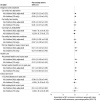State Minimum Wage and Mental Health Among Children and Adolescents
- PMID: 39441594
- PMCID: PMC11581516
- DOI: 10.1001/jamanetworkopen.2024.40810
State Minimum Wage and Mental Health Among Children and Adolescents
Abstract
Importance: Mental health disorders are increasing for children and adolescents in the US, with those in poverty having especially high rates. More evidence is needed about the association between economic policies, such as the minimum wage, and children's mental health.
Objective: To test the association between minimum wages and the mental health of children and adolescents.
Design, setting, and participants: This repeated cross-sectional, population-based US study used data from 2001 to 2022. Participants included state-representative, stratified random samples of children from the National Survey of Children's Health and adolescents from the Youth Risk Behavior Surveillance System. Data analysis was performed from January 2023 to August 2024.
Exposure: State minimum wage policies.
Main outcomes and measures: A total of 15 outcomes reported by caregivers or adolescents from survey data were evaluated: depression, anxiety, attention deficit disorder and/or attention-deficit/hyperactivity disorder, behavior disorders, mood symptoms, gastrointestinal symptoms, considered and attempted suicide, any unmet health care and mental health care, alcohol and marijuana use, physical fights, school absenteeism, and paid employment. The associations between minimum wage policies and mental health were tested using 2-way fixed-effects models, lifetime minimum wage models, and difference-in-differences models with event studies, all with state, year, and birth cohort fixed effects. Additional controls included individual-level demographics and state-level health insurance and welfare policies.
Results: Analyses included 239 534 children (aged 3-17 years; 117 111 girls [48.9%]) from the 2016 to 2022 National Survey of Children's Health, and 1 453 043 adolescents (aged 12-18 years; 711 380 girls [49.0%]) from the 2001 to 2021 Youth Risk Behavior Surveillance System. Across diverse modeling approaches, increases in minimum wages were not associated with clear, consistent improvements in mental health. For example, in 2-way fixed-effects models, a $1 increase in the minimum wage was not associated with changes in rates of depression (0.06 percentage points [pp]; 95% CI, -0.11 to 0.23 pp; P = .48), unmet mental health care (0.13 pp; 95% CI, -0.04 to 0.30 pp; P = .14), or attempted suicide (-0.17 pp; 95% CI, -0.47 to 0.13 pp; P = .26). There also were no clear improvements when stratifying by household income, parental education, race and ethnicity, nativity, or urbanicity.
Conclusions and relevance: In this repeated cross-sectional study, changes in minimum wage policies over the past 2 decades were not accompanied by clear improvements in children's and adolescents' mental health. More evidence is needed on policy approaches to improve the mental well-being of children, particularly those from economically disadvantaged families.
Conflict of interest statement
Figures


References
Publication types
MeSH terms
LinkOut - more resources
Full Text Sources
Medical
Miscellaneous

